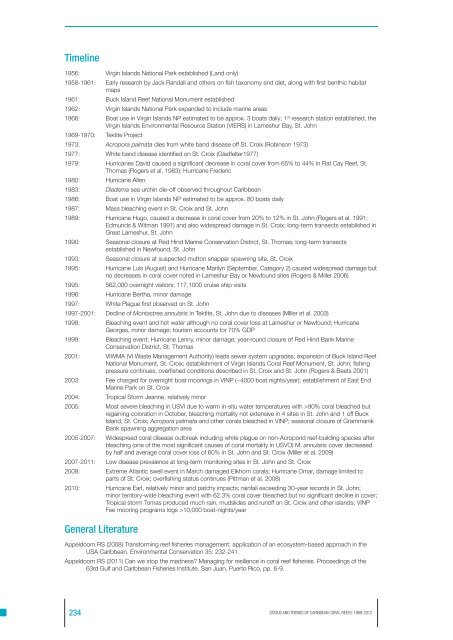Jackson2013-Status and Trendsof Caribbean Coral Reefs
Jackson2013-Status and Trendsof Caribbean Coral Reefs.pdf
Jackson2013-Status and Trendsof Caribbean Coral Reefs.pdf
Create successful ePaper yourself
Turn your PDF publications into a flip-book with our unique Google optimized e-Paper software.
Timeline<br />
1956: Virgin Isl<strong>and</strong>s National Park established (L<strong>and</strong> only)<br />
1958-1961: Early research by Jack R<strong>and</strong>all <strong>and</strong> others on fish taxonomy <strong>and</strong> diet, along with first benthic habitat<br />
maps<br />
1961: Buck Isl<strong>and</strong> Reef National Monument established<br />
1962: Virgin Isl<strong>and</strong>s National Park exp<strong>and</strong>ed to include marine areas<br />
1966: Boat use in Virgin Isl<strong>and</strong>s NP estimated to be approx. 3 boats daily; 1 st research station established, the<br />
Virgin Isl<strong>and</strong>s Environmental Resource Station (VIERS) in Lameshur Bay, St. John<br />
1969-1970: Tektite Project<br />
1973: Acropora palmata dies from white b<strong>and</strong> disease off St. Croix (Robinson 1973)<br />
1977: White b<strong>and</strong> disease identified on St. Croix (Gladfelter1977)<br />
1979: Hurricanes David caused a significant decrease in coral cover from 65% to 44% in Flat Cay Reef, St.<br />
Thomas (Rogers et al. 1983); Hurricane Frederic<br />
1980: Hurricane Allen<br />
1983: Diadema sea urchin die-off observed throughout <strong>Caribbean</strong><br />
1986: Boat use in Virgin Isl<strong>and</strong>s NP estimated to be approx. 80 boats daily<br />
1987: Mass bleaching event in St. Croix <strong>and</strong> St. John<br />
1989: Hurricane Hugo, caused a decrease in coral cover from 20% to 12% in St. John (Rogers et al. 1991;<br />
Edmunds & Witman 1991) <strong>and</strong> also widespread damage in St. Croix; long-term transects established in<br />
Great Lameshur, St. John<br />
1990: Seasonal closure at Red Hind Marine Conservation District, St. Thomas; long-term transects<br />
established in Newfound, St. John<br />
1993: Seasonal closure at suspected mutton snapper spawning site, St. Croix<br />
1995: Hurricane Luis (August) <strong>and</strong> Hurricane Marilyn (September, Category 2) caused widespread damage but<br />
no decreases in coral cover noted in Lameshur Bay or Newfound sites (Rogers & Miller 2006)<br />
1995: 562,000 overnight visitors; 117,1000 cruise ship visits<br />
1996: Hurricane Bertha, minor damage<br />
1997: White Plague first observed on St. John<br />
1997-2001: Decline of Montastrea annularis in Tektite, St. John due to diseases (Miller et al. 2003)<br />
1998: Bleaching event <strong>and</strong> hot water although no coral cover loss at Lameshur or Newfound; Hurricane<br />
Georges, minor damage; tourism accounts for 70% GDP<br />
1999: Bleaching event; Hurricane Lenny, minor damage; year-round closure of Red Hind Bank Marine<br />
Conservation District, St. Thomas<br />
2001: VIWMA (VI Waste Management Authority) leads sewer system upgrades; expansion of Buck Isl<strong>and</strong> Reef<br />
National Monument, St. Croix; establishment of Virgin Isl<strong>and</strong>s <strong>Coral</strong> Reef Monument, St. John; fishing<br />
pressure continues, overfished conditions described in St. Croix <strong>and</strong> St. John (Rogers & Beets 2001)<br />
2003: Fee charged for overnight boat moorings in VINP (~4000 boat nights/year); establishment of East End<br />
Marine Park on St. Croix<br />
2004: Tropical Storm Jeanne, relatively minor<br />
2005: Most severe bleaching in USVI due to warm in-situ water temperatures with >90% coral bleached but<br />
regaining coloration in October, bleaching mortality not extensive in 4 sites in St. John <strong>and</strong> 1 off Buck<br />
Isl<strong>and</strong>, St. Croix; Acropora palmata <strong>and</strong> other corals bleached in VINP; seasonal closure of Grammanik<br />
Bank spawning aggregation area<br />
2005-2007: Widespread coral disease outbreak including white plague on non-Acroporid reef-building species after<br />
bleaching (one of the most significant causes of coral mortality in USVO) M. annularis cover decreased<br />
by half <strong>and</strong> average coral cover loss of 60% in St. John <strong>and</strong> St. Croix (Miller et al. 2009)<br />
2007-2011: Low disease prevalence at long-term monitoring sites in St. John <strong>and</strong> St. Croix<br />
2008: Extreme Atlantic swell event in March damaged Elkhorn corals; Hurricane Omar, damage limited to<br />
parts of St. Croix; overfishing status continues (Pittman et al. 2008)<br />
2010: Hurricane Earl, relatively minor <strong>and</strong> patchy impacts; rainfall exceeding 30-year records in St. John;<br />
minor territory-wide bleaching event with 62.3% coral cover bleached but no significant decline in cover;<br />
Tropical storm Tomas produced much rain, mudslides <strong>and</strong> runoff on St. Croix <strong>and</strong> other isl<strong>and</strong>s; VINP<br />
Fee mooring programs logs >10,000 boat-nights/year<br />
General Literature<br />
Appeldoorn RS (2008) Transforming reef fisheries management: application of an ecosystem-based approach in the<br />
USA <strong>Caribbean</strong>. Environmental Conservation 35: 232-241.<br />
Appeldoorn RS (2011) Can we stop the madness? Managing for resilience in coral reef fisheries. Proceedings of the<br />
63rd Gulf <strong>and</strong> <strong>Caribbean</strong> Fisheries Institute. San Juan, Puerto Rico. pp. 6-9.<br />
234 STATUS AND TRENDS OF CARIBBEAN CORAL REEFS: 1969-2012


















